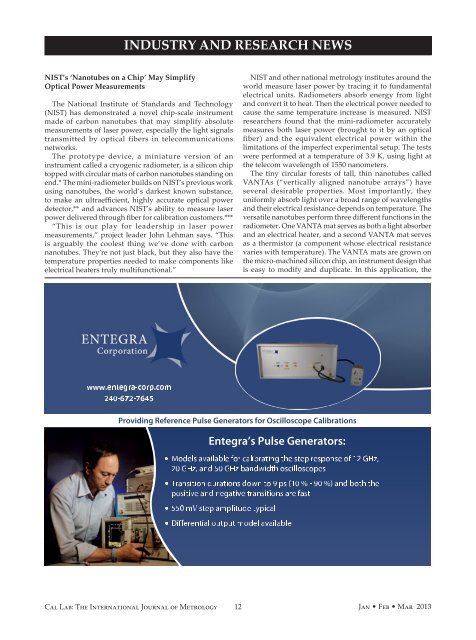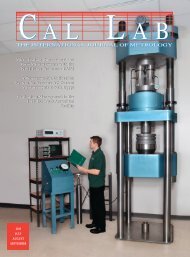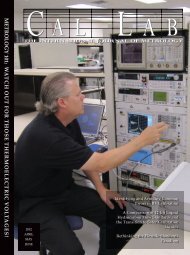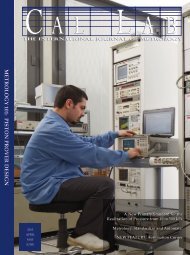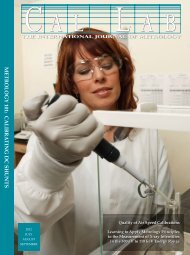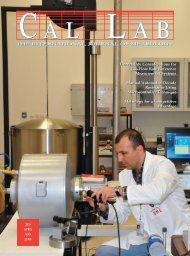Magazine – PDF - Cal Lab Magazine
Magazine – PDF - Cal Lab Magazine
Magazine – PDF - Cal Lab Magazine
Create successful ePaper yourself
Turn your PDF publications into a flip-book with our unique Google optimized e-Paper software.
INDUSTRY AND RESEARCH NEWSNIST’s ‘Nanotubes on a Chip’ May SimplifyOptical Power MeasurementsThe National Institute of Standards and Technology(NIST) has demonstrated a novel chip-scale instrumentmade of carbon nanotubes that may simplify absolutemeasurements of laser power, especially the light signalstransmitted by optical fibers in telecommunicationsnetworks.The prototype device, a miniature version of aninstrument called a cryogenic radiometer, is a silicon chiptopped with circular mats of carbon nanotubes standing onend.* The mini-radiometer builds on NIST’s previous workusing nanotubes, the world’s darkest known substance,to make an ultraefficient, highly accurate optical powerdetector,** and advances NIST’s ability to measure laserpower delivered through fiber for calibration customers.***“This is our play for leadership in laser powermeasurements,” project leader John Lehman says. “Thisis arguably the coolest thing we’ve done with carbonnanotubes. They’re not just black, but they also have thetemperature properties needed to make components likeelectrical heaters truly multifunctional.”NIST and other national metrology institutes around theworld measure laser power by tracing it to fundamentalelectrical units. Radiometers absorb energy from lightand convert it to heat. Then the electrical power needed tocause the same temperature increase is measured. NISTresearchers found that the mini-radiometer accuratelymeasures both laser power (brought to it by an opticalfiber) and the equivalent electrical power within thelimitations of the imperfect experimental setup. The testswere performed at a temperature of 3.9 K, using light atthe telecom wavelength of 1550 nanometers.The tiny circular forests of tall, thin nanotubes calledVANTAs (“vertically aligned nanotube arrays”) haveseveral desirable properties. Most importantly, theyuniformly absorb light over a broad range of wavelengthsand their electrical resistance depends on temperature. Theversatile nanotubes perform three different functions in theradiometer. One VANTA mat serves as both a light absorberand an electrical heater, and a second VANTA mat servesas a thermistor (a component whose electrical resistancevaries with temperature). The VANTA mats are grown onthe micro-machined silicon chip, an instrument design thatis easy to modify and duplicate. In this application, thewww.entegra-corp.com240-672-7645Providing Reference Pulse Generators for Oscilloscope <strong>Cal</strong>ibrationsEntegra’s Pulse Generators:Models available for calibrating the step response of 12 GHz,20 GHz, and 50 GHz bandwidth oscilloscopesTransition durations down to 9 ps (10 % - 90 %) and both thepositive and negative transitions are fast550 mV step amplitude typicalDifferential output model available<strong>Cal</strong> <strong>Lab</strong>: The International Journal of Metrology12 Jan • Feb • Mar 2013


